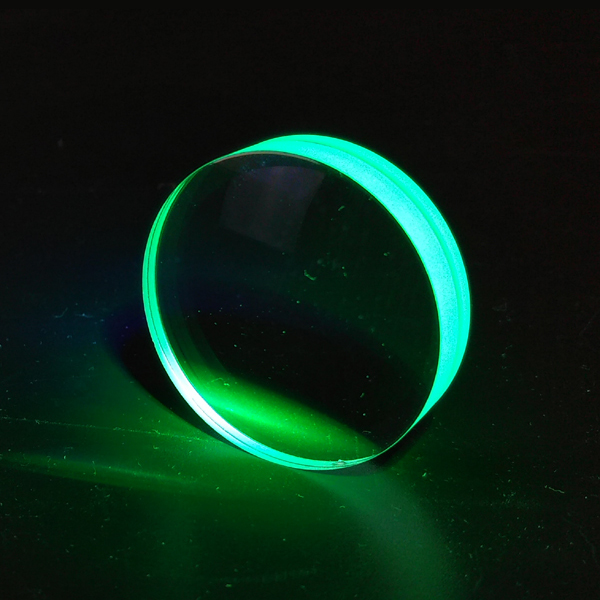Optical Cylindrical Lens
A cylindrical lens astigmatismis typically used to focus, condense or expand incoming light. Cylindrical optical lenseshaveone cylindrical surface, causing light to be focussed in a single dimension or axis. It can also be used to expand the output of a laser diode into a symmetrical beam. Cylindrical optical lenses are technically more difficult to manufacture than spherical or flat lenses which is why Ecoptik (also known as BRD Optical) uses state-of-the-art polishing techniques alongside stringent lens assessment to manufacture each lens.
A cylindrical optical lens is typically rectangular, square, or circular and of either a plano-convex or plano-concave design. The cylindrical optical lenses of Ecoptik (also known as BRD Optical) combine low wedge with high surface accuracy. As one of the best custom optical componentsmanufacturers, we assess the quality of each individual lens using Trioptics centration measurement and a Zygo GPI interferometer. All Ecoptiklenses are available both uncoated or coated with a broad range of high durability, low loss AR coatings, and can be manufactured to 20-10 surface roughness.
Optical Cylindrical Lens Uses
Cylindrical optics lens can converge or diverge light beams in a single axis. Cylindrical lens is used in many industries and fields such as optical metrology, laser scanning, spectroscopy, laser diode output beam shaping, and light-sheet illumination microscopic imaging.
Form the collimated light source into a line light source
This is the most widely used cylindrical lens. Taking a plano-concave cylindrical lens as an example, it can be a beam of collimated light that expands into a linear light source according to the magnification.
The cylindrical lens is also used for astigmatism. Collimation of diode output beam The output beam of the laser diode diverges in an asymmetrical form, and its collimation work is more challenging. For example, for a diode light source with a divergence angle, if only a standard spherical lens is used, it can only be collimated in a single direction, and divergence or convergence will occur in the other direction. Using cylindrical mirrors can decompose the problem into two one-dimensional directions. By combining two orthogonal cylindrical mirrors, the two directions can be collimated simultaneously.
Types of Cylindrical LensFAQS
What is difference between spherical and cylindrical lenses?
Spherical lenses are lenses taken out from a sphere such as a ball. Where as, cylindrical lenses are lenses taken out from a surface of a cylinder like a tumbler. Cylindrical lenses have an axis associated with them. Both, spherical and cylindrical power can keep changing through life.
What Does A Cylindrical Lens Do?
A cylindrical lens is typically used to focus, condense or expand incoming light. A cylindrical lens has one cylindrical surface, causing light to be focussed in a single dimension or axis. It can also be used to expand the output of a laser diode into a symmetrical beam.
How To Detect The Surface Fringe Of The Cylinder ?
We have zygo and professional lens cylinder inspection system, and can provide a full set of inspection reports.
Can You Provide The Main Processing Methods?
According to the quantity of the customer's order and the requirements of the lens index, the appropriate processing technology is selected. There are two types of classical processing methods and high-polishing processing methods.
If you want to know more details of cylindrical vs spherical lens, please visit our website.
在线联系供应商
Other supplier products
| Double Concave Lens | A double concave lens/double concave mirrorhas a negative focal length, thereby causing collimated incident light to diverge. The double concave le... | |
| Penta Prism | Pentagonal prism is the beam Angle (90 °), one of the steering gear.It has two purposes: one is that no matter how much the first incident Angl... | |
| Anamorphic Prism | BRD Opticalwas founded in 2004, and is located in the city of Changchun-the optic base of China with a beautiful view and profound optical culture.... | |
| Aluminum (Al) Mirror | Aluminum (Al) Mirror As an aluminum mirror manufacturer, Ecoptik (also known as BRD Optical) provide the round, square and customized shape optica... | |
| Neutral Density Filter | Neutral density filter ophthalmologyis often used in imaging or laser applications to avoid strong light damage to camera sensors or other optical ... |
Same products
| all kinds of Analytical Instruments | 卖方: O&K GROUP LIMITED | Okwishing供应各类分析仪器。 Okwishing()是一个跨境电商平台,致力于为全球消费者提供有效、优质的分析仪器产品。 基于中国分析仪器产业链供应能力,我们汇集了多样化的分析仪器类别... | |
| all kinds of Thermal Equipment | 卖方: O&K GROUP LIMITED | Okwishing供应各种热设备。 Okwishing()是一个跨境电子商务平台,致力于为全球消费者提供各种客户有效、优质的热设备。 我们的产品线涵盖闪光报警器、无纸记录仪、流量积算仪、压力... | |
| all kinds of Geological Exploration Equipment and Instruments | 卖方: O&K GROUP LIMITED | Okwishing供应各类地质勘探设备仪器。 Okwishing ()是一个跨境电商平台,致力于为全球消费者提供各类客户有效、优质的地质勘探设备仪器需求。 我们的产品线涵盖区域地质调查、海洋... | |
| all kinds of Optical Instruments | 卖方: O&K GROUP LIMITED | Okwishing供应各类光学仪器。 Okwishing ()是一个跨境电商平台,致力于为全球消费者提供各类客户需求的有效、优质的光学仪器。 我们的产品线涵盖光学测量仪器、光学测试仪器、显微... | |
| all kinds of Surveying and Mapping Instruments | 卖方: O&K GROUP LIMITED | Okwishing供应各类测绘仪器。 Okwishing ()是一个跨境电商平台,致力于为全球消费者提供各类客户有效、优质的测绘仪器需求。 我们的产品线涵盖表面经纬仪、陀螺经纬仪、矿用经纬仪... |





















